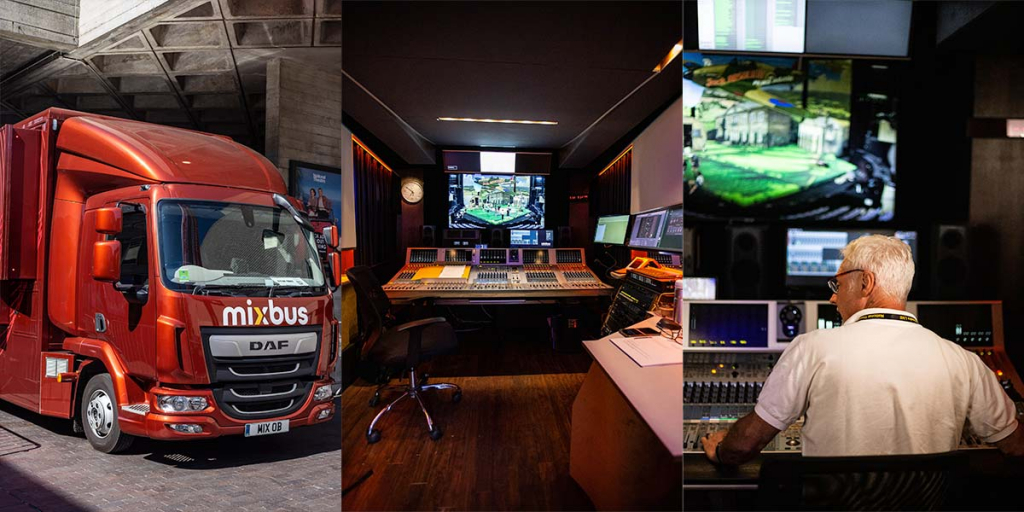
We chat to outside broadcast specialists ‘The MixBus’ (Conrad Fletcher and Chris Kalcov) about mixing sound for Live to Cinema in London.
‘Live to Cinema’ is the process of broadcasting live theatre productions directly to local cinemas around the world. Shown in over 65 countries (and to an audience of around 11 million people), National Theatre Live allows audiences across the world to experience the best plays that London and the UK has to offer – all from the comfort of a local cinema, and at a quality to rival the best seat in the house!
High-quality sound is of course a top priority, requiring a team of experienced professionals to ensure the audio is always up to scratch.
One such specialist is Conrad Fletcher. A sound supervisor with over 40 years in the industry, Conrad kindly allowed us on-board his OB Truck ‘The MixBus’, and – along with Sound Guarantee Chris Kalcov – treated us to a behind-the-scenes look at his main outside broadcast truck, which includes Synthax-supplied hardware from RME, Ferrofish and Appsys ProAudio.
A huge thanks to Conrad and Chris for providing us with many talking points for this interview, including some great insights into the recording of the numerous high-profile, internationally televised events the pair have worked on for the BBC.
Mixing Live to Cinema with Conrad Fletcher
and Chris Kalcov (RME Audio, Ferrofish, Appsys)
See more videos at Synthax TV
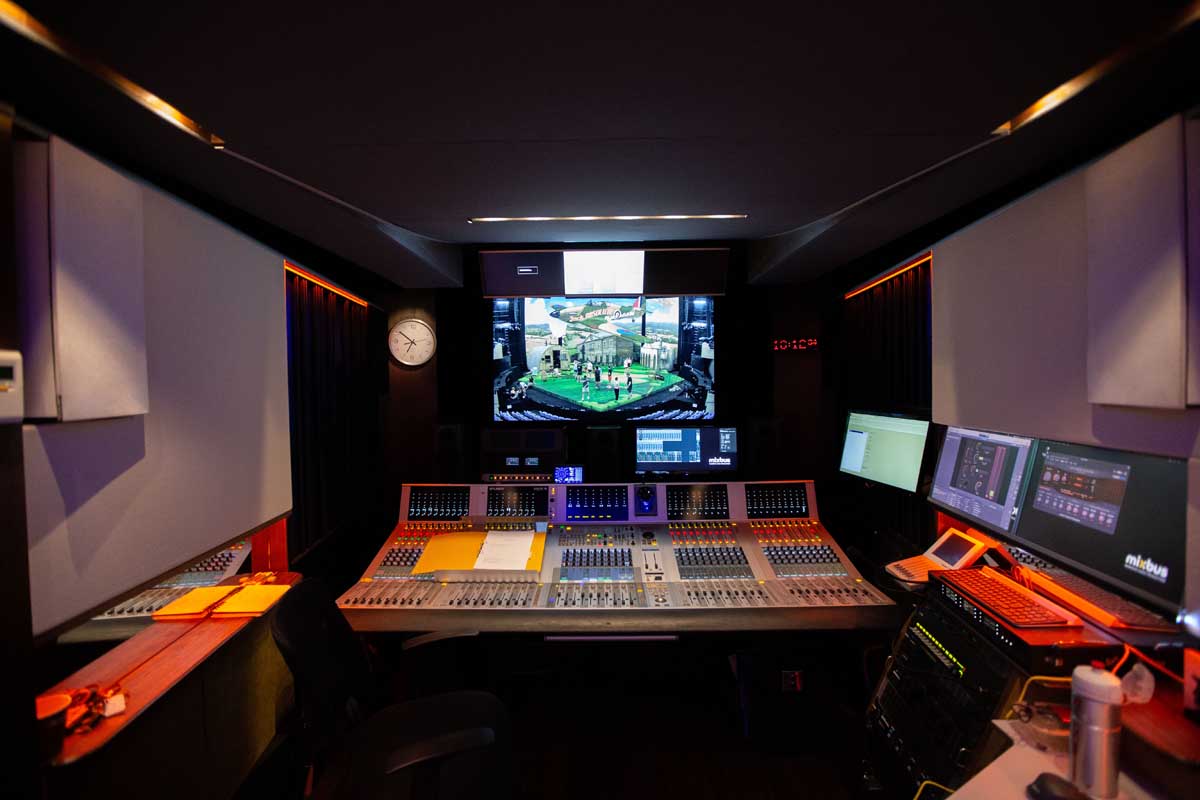 Conrad Fletcher’s Company SounDesign
Conrad Fletcher’s Company SounDesign
“SounDesign was set up originally for audio consultancy,” Conrad says of his company SounDesign. “I used to design studios and do studio treatment alongside broadcast work, although the Mixbus has kind of taken over now.”
“We have two trucks, the Mixbus and the Auxbus. The Mixbus is the big one which we’re in right now, and the Auxbus is a 3.5 ton version that offers the same technical facilities in a smaller footprint, for working in places like central London.”
“It’s a large-format 5.1 sound recording vehicle,” continues Sound Guarantee Chris Kalcov. “It’s built primarily around National Theatre Live, but it also does other live broadcasts from time to time – everything from music festivals, stadium concerts, live theatre, operas, ballets – it’s geared up to do anything where a sound facility is required for television.”
“We specialise in Live to Cinema,” continues Conrad. “But we also do music events, where we sub-hire the truck to the BBC, ITV etc. It’s done things like Later with Jools Holland – Tudor Davies mixes that, he likes the environment. We’ve also been doing the Michael Macintyre Show, where we’ll pull up outside one of the theatres in Central London for his live show.”
“It’s pretty plush inside,” adds Chris. “The idea is that if we have a music artist who the show is based around, they can come in here, where there’s a sofa and coffee machine, and they can enjoy watching back their performance on the big screen. Rather than being next door in the TV truck, where there’ll be a lot of shouting and fan noise. It’s just a nice place to be to watch the show, and provides a really good critical listening environment.”
“I’m a terrible business-person,” confesses Conrad. “So I like to rely on the output of what we do to sell the company. You do it for the love of it – we love to do what we do, we like to do a good job, and we like it to sound amazing ideally.”
“You do it for the love of it – we love to do what we do”
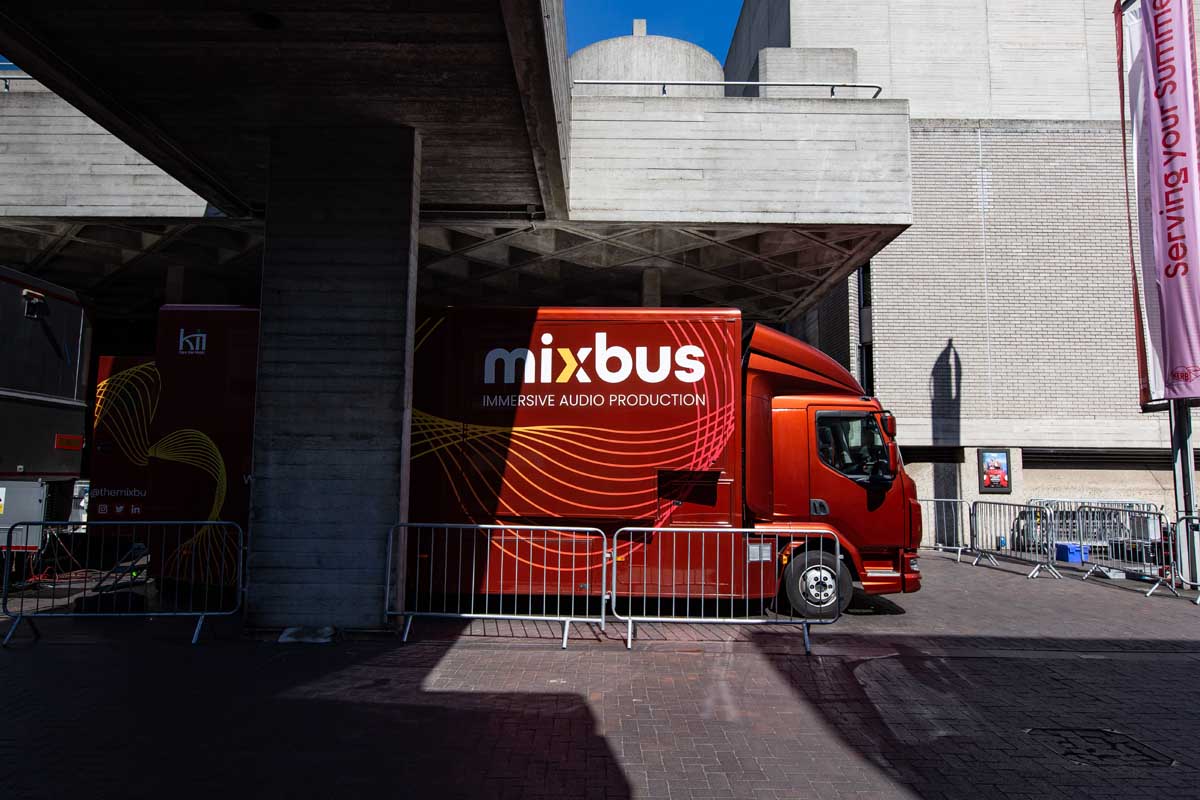 On Live to cinema
On Live to cinema
“Live to Cinema events really came about when the method of distributing films changed,” Chris explains. “And rather than a 35mm or 70mm celluloid reel going to each cinema, they started putting satellites on the roofs of the cinema to distribute the films. That of course meant that cinemas could receive things other than Hollywood films, and event cinema was born!”
“What we do is the broadcast mix, effectively a live film dub. That feeds into the television truck next door with the cameras, which all goes on to satellite so you can watch it in your local cinema.”
“The approach is similar to television,” says Conrad, on the subject of mixing. “There are certain directors who come from the film world, others who come from the TV world. But the idea is that it is specifically mixed, audio and video-wise, for a cinema audience. Everything is in at least 5.1, and we spend a lot of time making the audio sound as good as possible.”
“You could be sitting in a cinema in Newcastle, or Vancouver, or Sydney, and have the same experience as someone sitting in the middle of the auditorium, in the best seat in the house.”
Conrad’s Thoughts On Dolby Atmos
“Things are certainly heading towards Dolby Atmos. The problem is it’s really a post-production orientated format – it’s very difficult to get live productions sounding great in Atmos.”
“When we were involved in one of the Royal Weddings for example, they wanted to put that out in Atmos. Andy Payne, the Sound Supervisor had spent a lot of time focussing the sound, so that you only pick up what you want to hear. And in that instance, Dolby Atmos will most likely degrade the mix and have a negative effect, as you’ll start to hear things like Aircraft noise from overhead.”
“In terms of Dolby Atmos for Live to Cinema, another problem is the bandwidth needed for the signal. Rather than using AC3 which uses 640 kb/s, Dolby Atmos uses around 6Mb/s, which takes a significant chunk of the video resolution. So you end up hearing Atmos audio with lower quality video. For that reason we tend to stick to 5.1.”
Conrad Fletcher’s route into audio engineering
“Ah, a very short story of forty years..,” laughs Conrad when asked about his journey into audio engineering. “I started off at the University of Southampton doing a sound and vibration course. I only lasted two years in that course, because I was more interested in the broadcast side of things. So at the end of two years I left, drove a truck for a while which I didn’t really like all that much.”
“Then I ended up in the West End at the Theatre Royal, Drury Lane, doing 42nd Street as a showman, where I quickly progressed to doing sound. I met some of the guys from Autograph Sound who showed me the ropes, and I absolutely loved it, and ended up mixing the show.”
“Then I managed to get a job at the BBC, which was kind of luck really. I worked at Pebble Mill for twelve years doing radio, TV and film. I worked as a Boom Op for a while which I absolutely loved.”
“We did all sorts of things including OBs. I was on a vehicle called Stereo Control Vehicle 6, which was a big 28 ton multi-track mobile. I was on and off that for ten years, thinking ‘wow this would be great if I had something like this.’”
“I resigned from the BBC in 1996 and went freelance. I did Richard & Judy for a long time, then Big Brother. I was earning good money, but really I wanted to go back to my roots – I’m interested in being more creative and artistic, and so the way I thought I could do that was by building my own truck.”
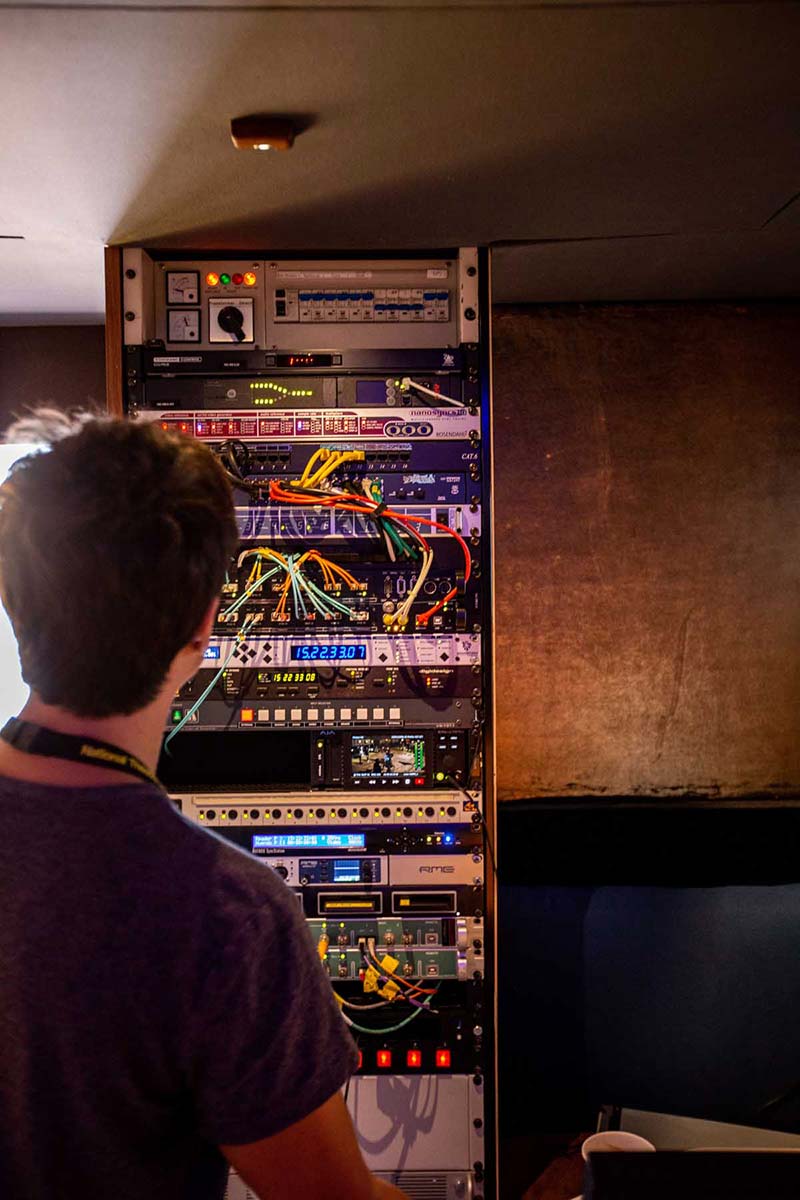 Inside The MixBus – Signal Flow
Inside The MixBus – Signal Flow
“In terms of input we have a mixture of stageboxes, Dante and MADI,” Chris tells us regarding the management of audio signals. “It can be one, or several of the three. If it’s Dante or MADI we usually sample rate convert to the clock that the scanner (another name for the Mobile Control Room) is using.”
“We have a master clock which everyone on the broadcast side syncs to. The venue will usually have their own master clock for their digital equipment. We use Appsys Multiverters to convert the sample rate from the source to whatever we’re working in.”
“They’re fantastic. They have bi-directional sample rate converters, so if we want to send anything back to the venue, it will arrive at their clock frequency, which makes things a lot easier.”
The Appsys Multiverter is a 64-channel digital audio format converter that can freely convert between a variety of digital audio formats, including Dante/AES-67, MADI and AES-50. An optional SRC provides on-board sample rate conversion, and additional formats can be added via Appsys’s range of Flexiverter extension boxes.
“We use Appsys Multiverters extensively because wherever we turn up, generally we’re taking sources from in-house,” continues Chris. “Whether they’re MADI optical, MADI coaxial, Dante or even AES 50, we know that if we put an Appsys Multiverter out there it can handle anything we throw at it.”
“We have stage boxes for the analogue sources, although MADI is generally preferred. Because with MADI, either it all works or it doesn’t, so it’s very easy to fault find. It also alleviates a slight worry I have with Dante, because sometimes we’re not in control of our own sources – everything is controlled via Dante controller, which is normally set up at the front of house position. So they control whether we get anything or not, and in a live situation that could be disastrous.”
“So the sources come into the desk, and we then go out to an RME MADI Bridge or MADI Router. They’re then routed via another RME box, the RME MADIface XT, which is an absolute mainstay. It takes three MADI streams and runs them onto our macs.”
“the RME MADIface XT, which is an absolute mainstay”
“So we’ve got up to 192 tracks in triplicate with three MADIface XTs. We’ve also got the HDSPe MADI FX which is a legacy product for us – we bought it before the MADIface XT came out. It’s probably about ten years old but it’s done sterling work.”
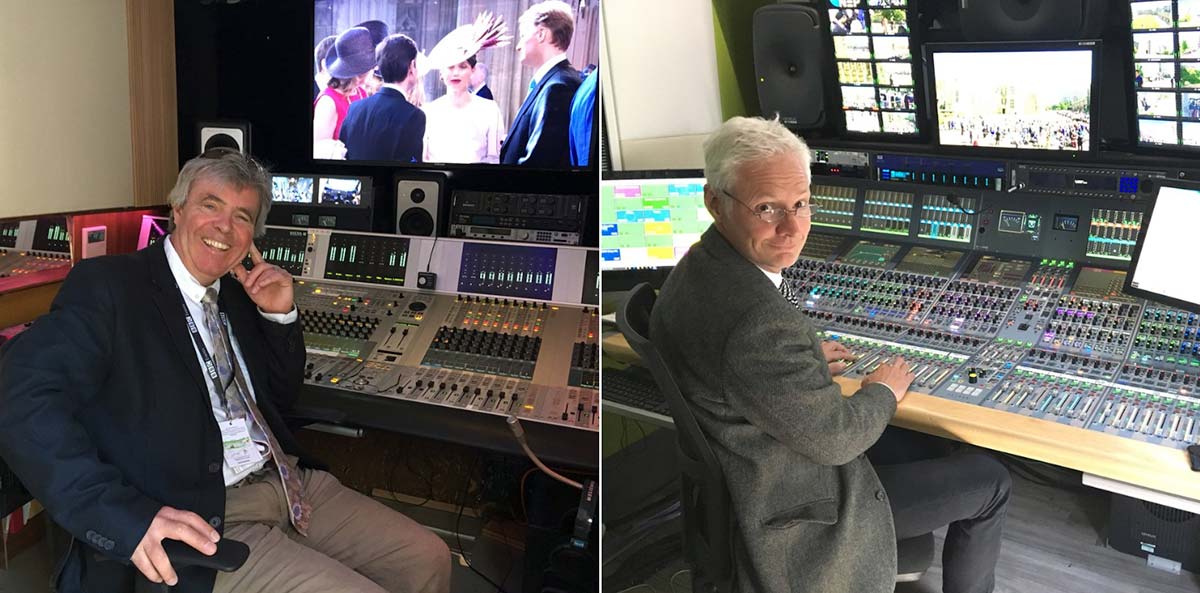 On mixing audio for state events
On mixing audio for state events
Both Conrad and Chirs have worked on many of the UK’s highest-profile live TV events. The BBC is renowned worldwide for their quality and professionalism, and such events require a particular approach to the recording and mixing – Chris kindly gave us a window into this world.
“I’m very fortunate to have worked with the BBC in the last few years, putting together televised state occasions,” says Chris. “Everyone has a great respect for the way we put them together. It’s a very core, tight-knit team; Conrad is normally one of the sound supervisors, as is Andy Payne, one of my colleagues who I’ve been training up with.”
“The old Mixbus was used for the wedding of Harry and Meghan for example, so all the feeds came into the vehicle with Andy Payne. That was fed to Conrad, and then sent to what’s called international sound, which are program feeds that the world’s media picks up on, and adds commentary to.”
“We come along as a large outside broadcast outfit. There’ll be quite a few scanners involved, as well as a number of video companies. The feeds we create have to go around the world, and are translated and cut together for news and other edits. But the very core of it is the coverage of the route, the outside coverage, and the church service.”
“When you’re approaching covering a service, especially a royal occasion, you have to be very sensitive to the way you capture it, without imposing on what is a very closed, private event. We need to portray everything as sensitively as possible.”
“One aspect to be aware of is the way the cameras and sound are rigged. In terms of microphones, you need a lot of coverage, to capture all of the congregation – the choir, the organ, the speech. And it’s extremely important that all the microphones are completely out of sight and unobtrusive – people should be able to attend the event and not be aware of them being there.”
“They get suspended from the roof of the cathedral so there’s never any microphone stands on the floor. Everything is completely out of the way. No one should ever have to think ‘this sound rig is in the way’.”
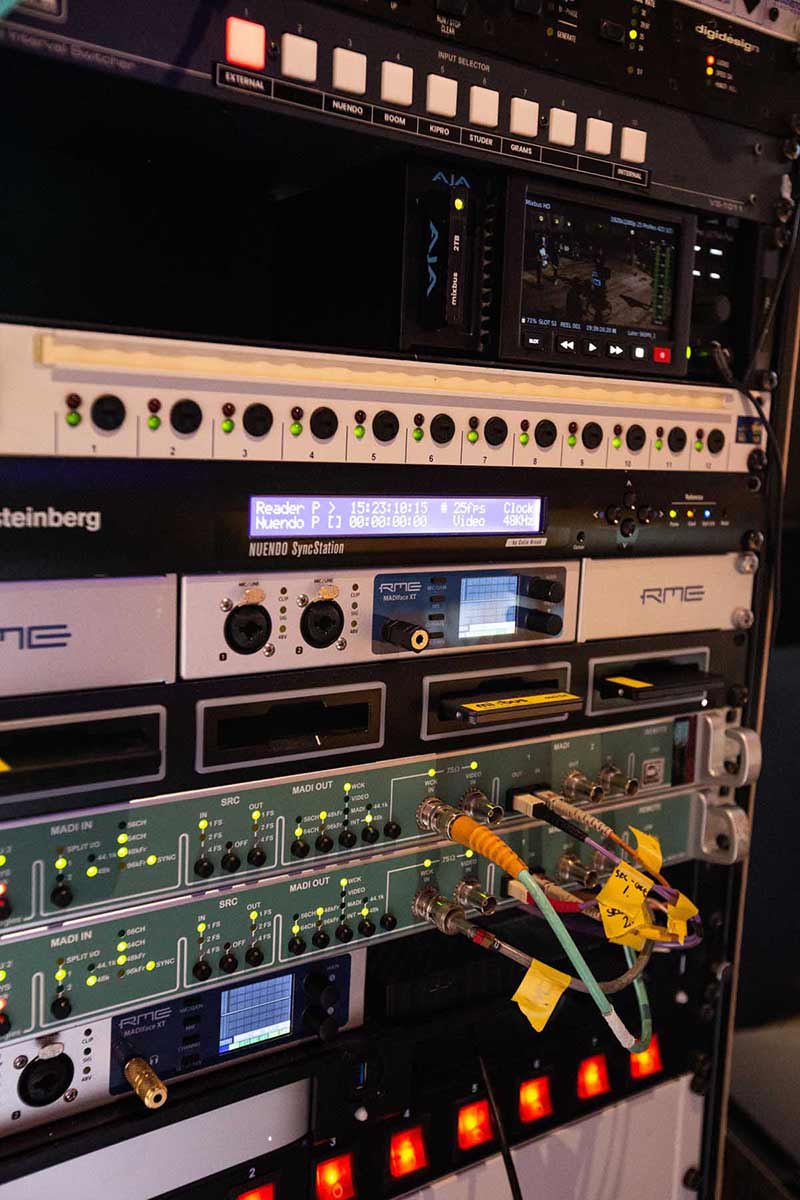 On RME Audio
On RME Audio
Both Conrad and Chris are long-time users of RME Audio, with RME’s range of interfaces and converters used extensively across the worlds of recording studios, live sound, location music recording and audio for broadcast.
“I first came across RME when I bought a Fireface 800,” says Conrad. “It was 1U, had good reviews. I was doing playback on TV for sound effects and a bunch of other things. I quickly realised it’s actually a lot more than it appears, it was able to do so much stuff, like format conversion with multiple outputs.”
“Then I bought an ADI-4 DD which is a standalone format converter, so that I could convert the ADAT to AES, and it just mushroomed from there. Everything I bought seemed to just work first time, and it sounded amazing.”
“I’m fortunate to work with quite a few of the Sound Mobile companies,” says Chris. “And in every truck you find RME equipment, and RME devices never fall over. We rely on putting entire programme feeds through MADI Routers, and incoming feeds through MADI Routers and MADI Bridges. They always just tickle on in the background. We love RME equipment – it just works, sounds good and always does the job.”
“We’ve got Octamics, Chris has bought some Micstasys,” says Conrad. “We’ve got ADI-842s, ADI-632s… Basically a whole gamut of RME gear, that performs not just one function but many functions, exceptionally well. It’s incredibly reliable and the sound quality is excellent.”
“One thing we take for granted is RME’s Steadyclock,” says Chris of RME’s digital clocking technology. “The great thing about SteadyClock is you can just plug MADI directly into a device, and it will sort out all the jitter problems, it’s very forgiving.”
“So you can just plug a MADI feed in, optical for instance, God knows where it’s come from, and it locks to it and stays locked. We generally like to go from RME into something else, as we know the MADI it’s sending out is always high quality.”
“We love RME equipment – it just works, sounds good and always does the job.”
On RME’s TotalMix FX
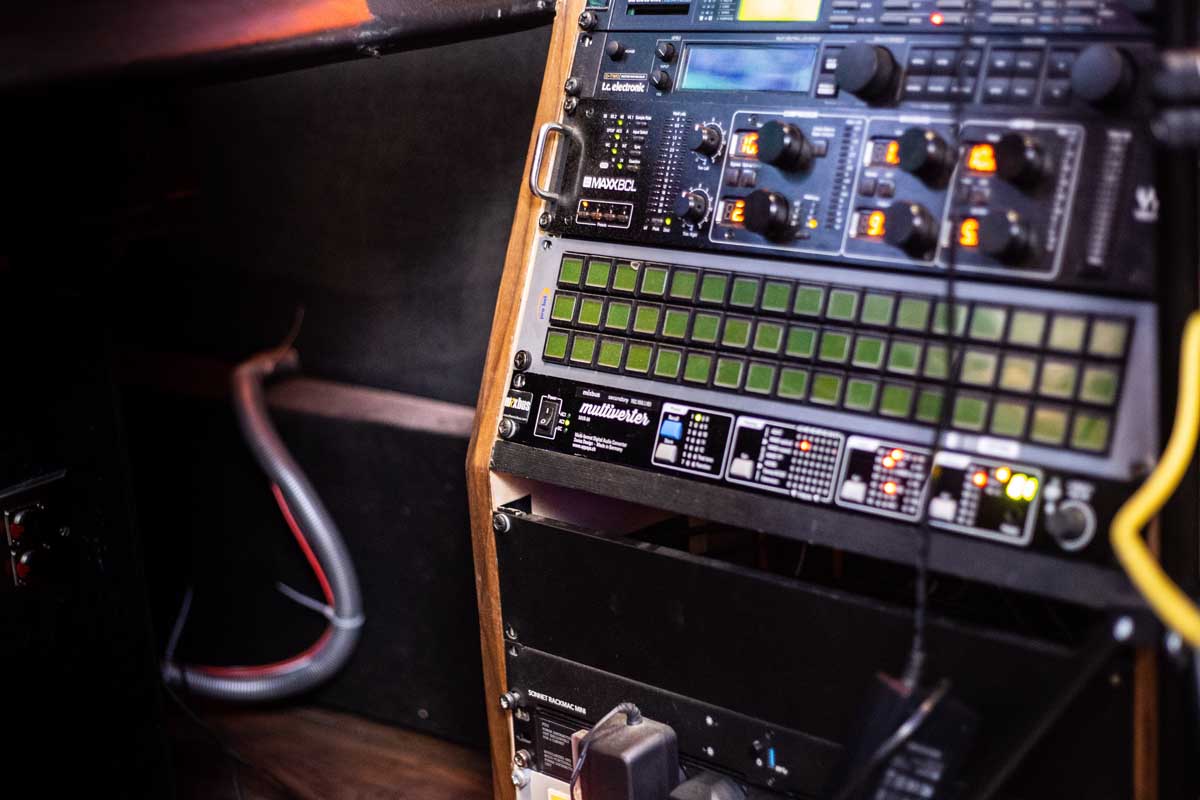 Regular users of RME interfaces will know all about TotalMix FX, RME’s powerful software controller that provides control over all inputs and outputs.
Regular users of RME interfaces will know all about TotalMix FX, RME’s powerful software controller that provides control over all inputs and outputs.
Essentially a digital mixing console built into each RME sound card or audio interface, TotalMix FX allows for the creation of unlimited submixes, as well as the saving and loading of workspaces and individual mix states.
“Conrad’s system is entirely RME-based,” says Chris on the subject of TotalMix. “When we’re doing outside broadcasts, where there’s no room or parking dispensation to place a truck or van, we’ll use a De-rig system. Then the beauty of using something like the MADIface XT is that it has TotalMix, which is so incredibly powerful.”
“You can create feeds and generate submixes to anywhere. And in the world of broadcast, it’s all about generating feeds. TotalMix can run off of a laptop, so instead of having to bring in a big digital desk, split the MADI into the desk and generate feeds from that, you can literally plug a laptop in, generate feeds in TotalMix. And then actually unplug your laptop and switch it off whilst the feeds stay cooking in the box. You store it all as pre-sets and you switch it off at the end of the day, then switch it back on the next, and everyone’s feeds come good.”
“And it’s all being done inside this little device that you’re primarily using as a recording device. But it’s also managing all these feeds that a big DigiCo would need to do.”
“I’m aware of at least one major artist out with a band, who actually got rid of the front of house desk, and was just using Totalmix,” adds Conrad. “Which was kind of a revelation.”
“We also had a very particular problem which TotalMix solved for us. We needed the front speakers in the MixBus to sound like the rear speakers, which required EQ’ing them in the highest possible quality. So we bought a Fireface UFX and used the ADAT output of the desk to feed into the UFX, and used the EQ in TotalMix before returning to the desk.”
“That’s the thing about RME, it seems to be the highest reliability and highest sound quality, which is all you can ask for really.”
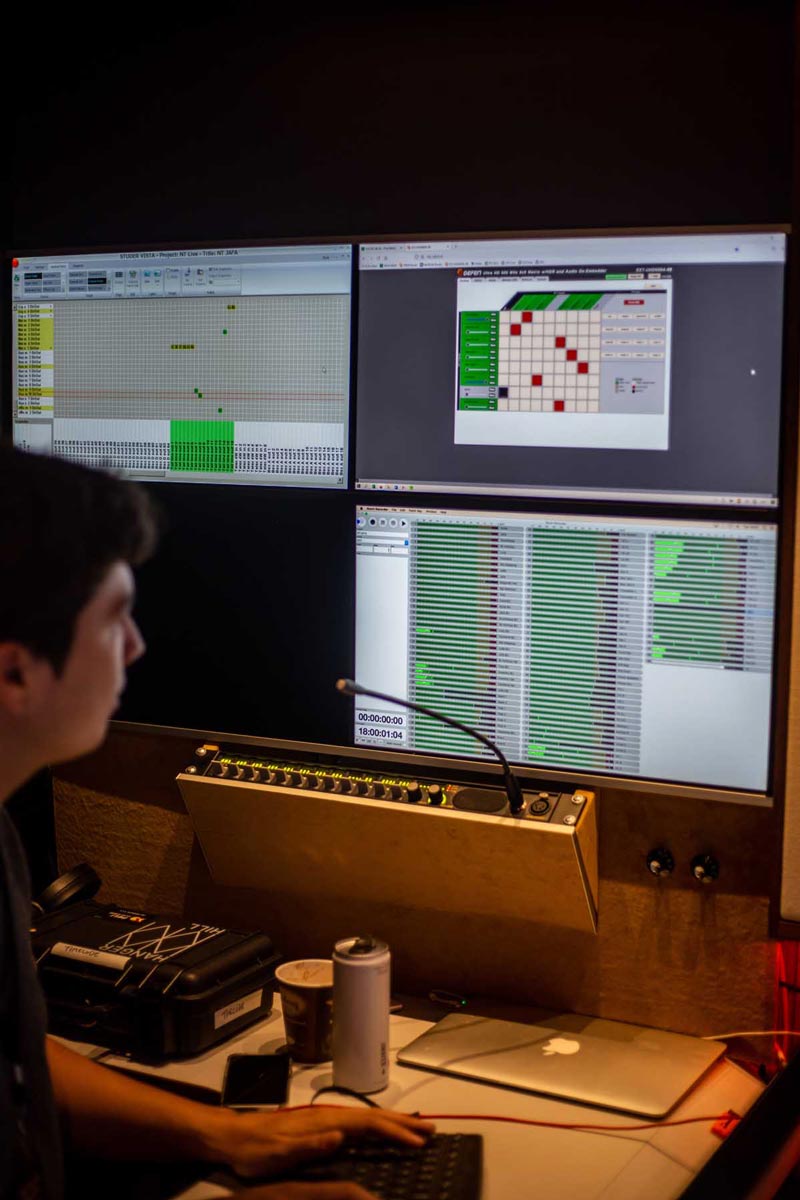 On the Ferrofish A32pro Dante
On the Ferrofish A32pro Dante
With the Mixbus beginning to feel like a bit of a ‘Synthax shop on wheels’, we were pleased to find out the MixBus also uses AD/DA converters from Ferrofish. Something of a ‘word of mouth’ brand, Conrad and Chris said their interest was piqued by the sheer number of engineers they’d ran into who also had a Ferrofish in the rack.
“A lot of theatres have started moving over to Dante now, which makes absolute sense for the vast majority of installed shows,” says Chris. “It allows programme feeds to be sent wherever they need to be in-house.”
“The downside is that in the world of Outside Broadcast, most trucks are still MADI-based. We’re still MADI based here, so in order to interface Dante and the MADI world, we either use Appsys, or quite recently we’ve been using Ferrofish, which we came across when we were doing festivals, and kept seeing these Ferrofish A32s as part of people’s live rigs.”
“So we’re going ‘oh you’ve got a Ferrofish box – oh you’ve got one as well, what are you using your’s for?’ And people would say ‘I’m just doing a bit of format conversion’, and all these Front of House and Monitor guys were saying ‘yeah I’ve not really paid much attention to it, it just sort of sits there working.’”
“have no fear, these things are incredible”
“They fitted the bill,” says Conrad. “I asked a few of my friends, said they need to be 100% reliable. And all of them, without fail, said ‘have no fear, these things are incredible.’”
“Then we turned up here at the National Theatre, and it turns out every show we’ve been working on for the last three years has run through a Ferrofish A32. It’s been switched on for over three years without being rebooted! They’re absolutely reliable, so we knew that was the device for us.”
Massive thanks to Conrad Fletcher and Chris Kalcov for inviting us on-board!
To find out more about the work offered by Conrad and his team, visit the Mixbus website.
See the full range of RME Audio devices
See the full range of Ferrofish devices
See the full range of Appsys ProAudio devices
![]() If you’d like to know more about any of the products we supply, give us a call on 01727 821 870 to speak to one of our team or to arrange a demo.
If you’d like to know more about any of the products we supply, give us a call on 01727 821 870 to speak to one of our team or to arrange a demo.
You can also contact us here.



















